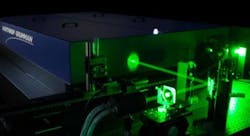Northrop Grumman installs new joule-class laser at Lawrence Livermore National Laboratory
Northrop Grumman Cutting Edge Optronics (CEO; St. Charles, MO) has installed and commissioned its new joule-class Gigashot-HETM diode-pumped solid-state (DPSS) laser system at Lawrence Livermore National Laboratory (LLNL; Livermore, CA). The laser will be used as a key component of LLNL's high-repetition-rate advanced petawatt laser system (HAPLS).
The HAPLS laser system is destined for the European Union's Extreme Light Infrastructure (ELI) Beamlines high-intensity laser-science facility currently under construction in the Czech Republic. The injection-seeded, diode-pumped Gigashot-HE laser outputs 2 J of 532 nm energy in each sub-10 ns pulse at 10 Hz with a near-field flat-top beam profile, making it an ideal pump source for one of HAPLS high energy Ti:Sapphire amplifier stages.
10 Hz repetition rate
HAPLS is designed to generate 30 J pulses with a pulse duration shorter than 30 fs, delivering a peak power greater than 1 petawatt (PW) at a repetition rate of 10 Hz. This very high repetition rate is a major advance, says CEO, considering that current petawatt laser systems fire a maximum of once per second.
Generation of high-brightness x-rays and acceleration of charged particles are a few examples of the many uses of such ultrashort, high energy pulses. HAPLS will enable new science discoveries in physics, chemistry, biochemistry, and medicine at the ELI Beamlines facility. ELI Beamlines will ultimately be a users' facility, where the variety and number of planned experiments will require fully automated, reliable, and low-maintenance laser operation, which is made possible through the HAPLS' use of all-diode-pumped laser technology, says CEO.
More than 10 billion shots
The Gigashot-HE consists of four PowerPULSE laser modules: one oscillator, one pre-amplifier, and two power amplifiers, using radially side-pumped Nd:YAG rods ranging in diameter from 3 to 18 mm. Each laser module is pulse-pumped by laser-diode arrays manufactured on-site at CEO's Missouri facility. The arrays have an expected lifetime in excess of 10 billion shots, which equates to more than 30 years of continuous operation at 10 Hz.
Source: http://cuttingedgeoptronics.com/2015/02/05/ceo-laser-installs-joule-class-laser-llnl/

John Wallace | Senior Technical Editor (1998-2022)
John Wallace was with Laser Focus World for nearly 25 years, retiring in late June 2022. He obtained a bachelor's degree in mechanical engineering and physics at Rutgers University and a master's in optical engineering at the University of Rochester. Before becoming an editor, John worked as an engineer at RCA, Exxon, Eastman Kodak, and GCA Corporation.
